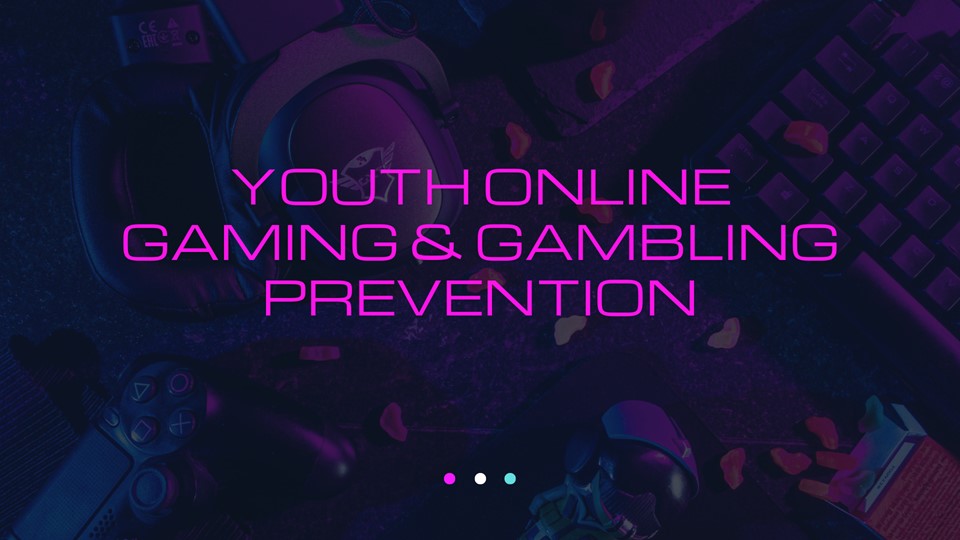Youth Online Gaming and Gambling Prevention
 Introduction
Introduction
Watch a video presentation or download Powerpoint slides on the information that follows below.
As gaming and gambling become more normalized in American society, it is important to keep in mind that a percentage of youth will experience problems. Prevention education efforts aimed at alcohol, tobacco, drug use and antisocial behaviors, should be extended to youth gambling.
The youth gambling fact sheet from the International Center for Responsible Gaming, summarizes the research that shows that problem gambling co-occurs with other risky behaviors for children and adolescents, including smoking, alcohol use, and drug use. According to Change the Game - Unlock the Reality of Youth Gambling, a site of Ohio for Responsible Gambling, one youth out of 20 (ages 14-21) is at risk for problem gambling, and children introduced to gambling by age 12 are four times more likely to develop a gambling problem. This is especially a concern since many gaming apps, which simulate the same excitement and risky activation of the brain-reward circuit that is experienced by gamblers, are marketed to children as young as two years of age; at the same time, there is also growing casual exposure of youth to parents and adults betting on sports or buying lottery tickets with the expansion of gaming and gambling opportunities across the US.
Problem Gambling – Recognizing symptoms
Youth gambling refers to gambling activities engaged in by minors or young people under the age of 18 or 21, depending on the jurisdiction. This type of gambling is problematic because of the potential for young people to become addicted to gambling and develop negative social, financial, and health consequences. According to the Virginia Council on Problem Gambling, the symptoms include:
- increasing preoccupation with gambling,
- a need to bet more money and/or more frequently,
- restlessness or irritability when attempting to stop,
- “chasing” losses, and
- loss of control manifested by continuation of the gambling behavior in spite of mounting, serious, negative consequences.
 Risky
Youth Gambling
Risky
Youth Gambling
While typically thought of as an adult issue, there are several ways that youth under the age of 18 might engage in gambling, including:
- Online gambling: This includes various online gambling activities through the internet, including casino games, sports betting, and lottery games.
- Social gambling: This would include playing cards for money or betting on sports games with friends.
- Illegal street gambling: Examples are playing games of chance for money or betting on illegal sports events.
- Video games with gambling elements: Some video games, particularly those with "loot boxes", can contain elements of gambling that can be attractive to youth.
 Risky
Youth Gaming
Risky
Youth Gaming
With regards to online and video game gambling, there are several types of games on mobile apps that could potentially foster gambling addiction in children. These games are not considered to be the same as traditional gambling; however, they can still be addictive and harmful, especially for children and youth.
- Games with loot boxes: These games allow players to purchase virtual boxes that contain randomized in-game items, and the thrill of not knowing what they will get can be addictive.
- Casino-style games: Some mobile games simulate casino games such as slot machines or poker, which can encourage players to make in-app purchases to continue playing or to win virtual money.
- Social casino games: These games are marketed as free to play, but often offer in-app purchases for virtual chips that can be used to play casino-style games.
- Games with in-app advertisements: Some mobile games feature advertisements that offer rewards for watching ads, such as virtual currency or in-game items. This type of reward system can be addictive, especially for children.
What can educators do?
To prevent potential addiction and to avoid disastrous outcomes that can occur for individuals who begin gambling young, is important for educators to proactively engage in preventative measures that can support children towards choosing options other than gambling.
- Review information on problem gambling and it’s red-flag behaviors, including the information available on the Virginia Council for Problem Gambling resource site.
- Educate children about the dangers of gambling behaviors. Here are some ways teachers can approach this topic in the classroom:
- Incorporate information about gambling into relevant subjects: Health teachers can work with other teachers to include information about gambling and its potential consequences in subjects such as health, social studies, or personal finance.
- Use interactive activities: Engage students with interactive activities such as role-playing exercises, group discussions, or debates to help them understand the dangers of gambling.
- Provide resources: Provide students with resources such as books, articles, videos, and websites that discuss the dangers of gambling and provide information on how to seek help if needed.
- Foster open communication: Create an open and supportive classroom environment where students feel comfortable discussing their experiences with gambling and asking questions.
- Collaborate with outside organizations: Collaborate with local organizations, such as youth support groups, to bring in experts to speak to students about the dangers of gambling.
Instructional Ideas – Resources for Preventing Youth Gambling Problems
Gambling Research Centers
- Gambling Research Exchange Ontario (GREO)
- Harvard Medical School Division of Addictions
- The Institute for Research on Pathological Gambling and Related Disorders
- McGill University’s International Center for Youth Gambling Problems and High-Risk Behaviors
- National Council on Problem Gambling
- New York Council on Problem Gambling
- North American Training Institute
- International Center for Responsible Gaming
- University of Nevada’s Institute for the Study of Gambling and Commercial Gaming
Prevention and Treatment - Education Sites
- College Gambling.org
- Gambling Addiction Prevention Act – Get Set Before You Bet
- Gambling, Gaming &Technology Use - Knowledge Exchange
- International Centre for Youth Gambling Problems and High-Risk Behaviors
- International Center for Responsible Gaming
- Knowtheodds.org
- Lane Co. Oregon Problem Gambling Prevention Program
Resource & Curricula Guides
- Adolescent Problem Gambling – A Prevention Guide for Parents
- High School Health: Teen Gambling Awareness Curriculum – Oregon Healthy Kids and Oregon Problem Gambling Services
- Gambling Problems: An Introduction for Behavioral Health Providers – SAMHSA Advisory
- Kids Don’t Gamble – Wanna Bet? Curriculum - North American Training Institute – Problem Gambling Services
- Problem Gambling Prevention Resource Guide for Prevention Professionals (2003)
- SAMHSA Problem Gambling Toolkit
- The Dangers of Youth Gambling Addiction – KnowtheOdds.org
- Add Know the Odds = Underage Gambling Education Resource
State Problem Gambling Services
- Adolescent Problem Gambling – A Prevention Guide for Parents
- High School Health: Teen Gambling Awareness Curriculum – Oregon Healthy Kids and Oregon Problem Gambling Services
- Gambling Problems: An Introduction for Behavioral Health Providers – SAMHSA Advisory
- Kids Don’t Gamble – Wanna Bet? Curriculum - North American Training Institute – Problem Gambling Services
- Problem Gambling Prevention Resource Guide for Prevention Professionals (2003)
- SAMHSA Problem Gambling Toolkit
- The Dangers of Youth Gambling Addiction – KnowtheOdds.org
Other Articles & Books
- 8 Signs of a Gambling Addiction
- Adolescent problem gambling requires community-level health promotion approaches
- Canadian Journal of Addiction – 11 Feature Articles on Gambling
- Compulsive Gambling – Symptoms and Causes
- High School Gambling Fact Sheet
- How Casinos Enable Gambling Addicts
- How the Brain Gets Addicted to Gambling
- International Centre for Youth Gambling Problems and High-Risk Behaviors – Progress Report
- Is there a cure for America’s Gambling Addiction?
- Gambling Addiction
- Gambling addiction: symptoms, triggers, and treatment
- Gambling Addiction Treatment Program Options
- Gambling disorder in adolescents: prevalence, new developments, and treatment challenges
- Gambling behaviors and attitudes in adolescent high school students: Relationships with problem-gambling severity and smoking status
- Mind, Body and Sport: Gambling among student-athletes
- Problem Gambling - NCDHHS
- Similarities and differences between pathological gambling and substance use disorders: a focus on impulsivity and compulsivity
- Social Marketing Campaigns for Youth Gambling Prevention: Lessons Learned From Youth
- The Connection Between Gambling and Substance Abuse
- The Efficacy of a Gambling Prevention Program Among High School Students
- The WAGER - Weekly Gambling Education Report – Research Bulletin
- Understanding a Growing Epidemic – TEEN GAMBLING
- What Clinicians Need to Know About Gambling Disorders
- Youth gambling education and prevention: Does it work?

